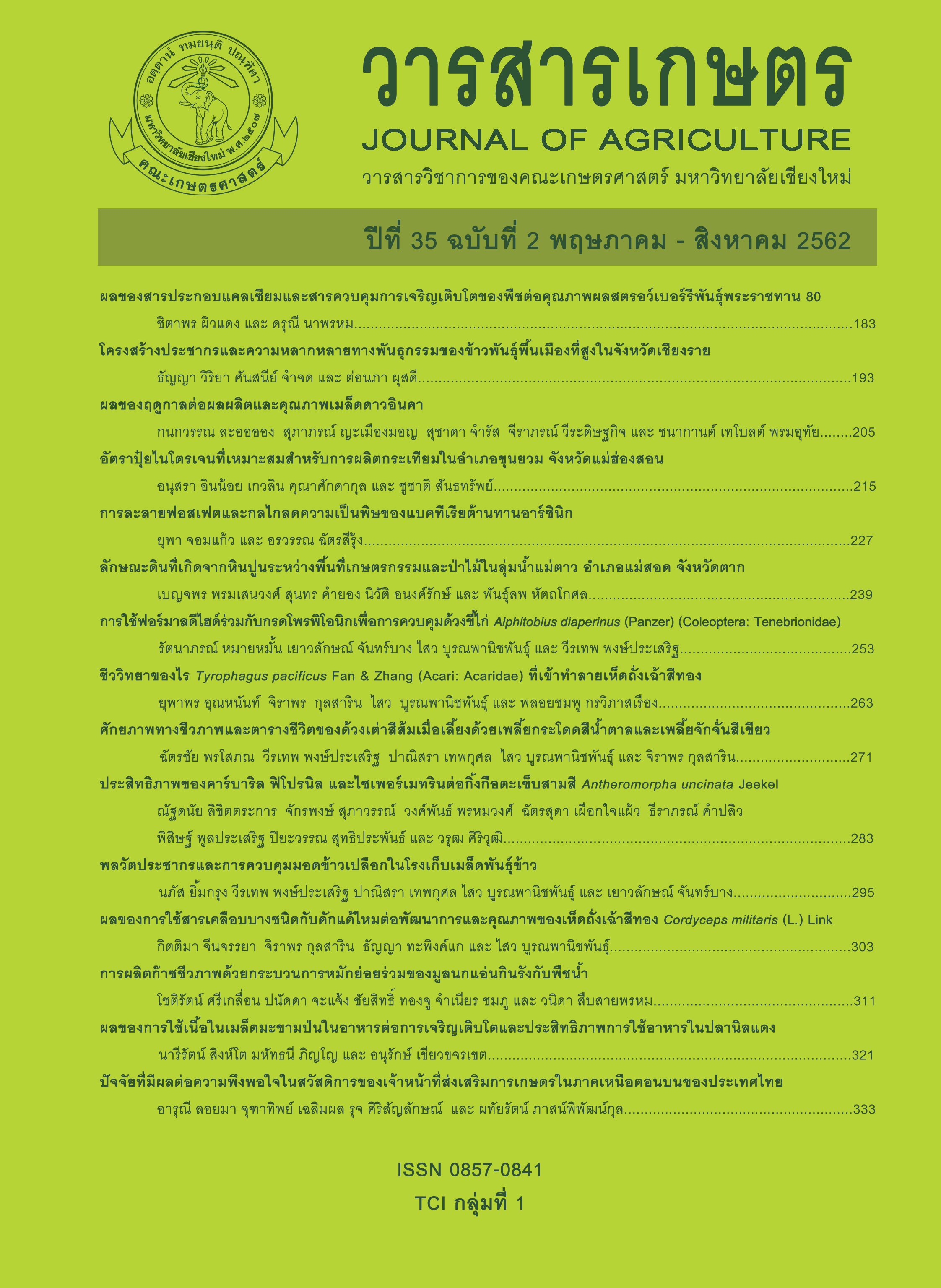การละลายฟอสเฟตและกลไกลดความเป็นพิษของแบคทีเรียต้านทานอาร์ซินิก
Main Article Content
บทคัดย่อ
อาร์ซินิกซึ่งรู้จักกันดีว่าเป็น “ราชาแห่งสารพิษ” พบว่า มีการปนเปื้อนในดินที่ใช้ทำการเกษตรในเขตภาคเหนือ ของประเทศไทย อย่างแพร่หลายมากกว่าโลหะหนักชนิดอื่น ดังนั้นจึงมีความเสี่ยงสูงที่จะปนเปื้อนในห่วงโซ่อาหารและเป็นอันตรายต่อสุขภาพของประชาชน จุลินทรีย์หลายชนิดเปลี่ยนรูปอาร์ซินิกให้อยู่ในรูปที่เป็นพิษน้อยลงซึ่งเป็นกลไกหนึ่งในการต้านทาน ในการทดลองครั้งนี้ ได้ทำการประเมินความสามารถในการเปลี่ยนแปลงพีเอช (pH) และ การละลายฟอสเฟต ภายใต้ความเข้มข้นของอาร์ซิไนท์หลายระดับ ของเชื้อคัดเลือก 5 ไอโซเลท คือ BAs7, BAs8, BAs11, BAs19 และ BAs29 ผลการทดลองชี้ให้เห็นว่า แต่ละไอโซเลทสามารถเจริญได้ในอาหารที่ผสมอาร์ซิไนท์ก็ต่อเมื่อเชื้อนั้นสามารถเพิ่มค่า pH ของอาหารให้เป็นด่างมากขึ้น (ประมาณ ≥ 5.0-6.0) แสดงให้เห็นถึงการปลดปล่อยสารประกอบที่เป็นด่างเพื่อเป็นกลไกลดความเป็นพิษ ความสามารถในการละลายฟอสเฟตของแต่ละไอโซเลทเพิ่มขึ้นเมื่อสัมผัสกับอาร์ซิไนท์ที่มีความเข้มข้นเพิ่มมากขึ้นซึ่งแสดงถึงการดูดใช้อาร์ซินิกที่ลดลงจึงทำให้ความต้านทานสูงขึ้น อย่างไรก็ตาม ความสามารถในการละลายฟอสเฟตลดลงอย่างชัดเจนที่ความเข้มข้นวิกฤตของอาร์ซิไนท์ซึ่งแตกต่างกันไปในแต่ละไอโซเลท สำหรับการทดลองนี้ ความเข้มข้นวิกฤตที่ทำให้ความสามารถในการละลายฟอสเฟตลดลงอย่างเด่นชัดของไอโซเลท BAs7, BAs8, BAs11, BAs19 และ BAs29 คือ 50, 100, 50, 100 และ 100 mg Na-As(III) ตามลำดับ ผลการทดลองที่สำคัญในครั้งนี้คือ กลไกการลดความเป็นพิษสองกลไก ได้แก่ การเปลี่ยนแปลงค่าของ pH ให้มีสภาพเป็นด่าง และ การเพิ่มความสามารถในการละลายฟอสเฟตของแบคทีเรียต้านทานอาร์ซินิก
Article Details
References
Abou-Shanab, R.A., J.S. Angle, T.A. Delorme, R.L. Chaney, P. Van Berkum, H. Moawad, K. Ghanem and H.A. Ghozlan. 2003. Rhizobacterial effects on nickel extraction from soil and uptake by Alyssum murale. New Phytologist 158(1): 219-224.
Akhtar, M.S., B. Chali and T. Azam. 2013. Bioremediation of arsenic and lead by plants and microbes from contaminated soil. Research in Plant Sciences 1(3): 68-73.
Aposhian, H.V., R.A. Zakharyan, M.D. Avram, M.J. Kopplin and M.L. Wollenberg. 2003. Oxidation and detoxification of trivalent arsenic species. Toxicology and Applied Pharmacology 193(1): 1-8.
Bano, N. and J. Masarrat. 2003. Characterization of a new Pseudomonas aerunginosa strain NJ-15 as a potential biocontrol agent. Current Microbiology 46(5): 324-328.
Chen, W., F. Yang, L. Zhang and J. Wang. 2016. Organic acid secretion and phosphate solubilizing efficiency of Pseudomonas sp. PSB12: Effects of phosphorus forms and carbon sources. Geomicrobiology Journal 33(10): 870-877.
Das, S., J.S. Jean, S. Kar and C.C. Liu. 2013. Changes in bacterial community structure and abundance in agricultural soils under varying levels of arsenic contamination. Geomicrobiology Journal 30(7): 635-644.
Farwell, A.J., S. Vesely, V. Nero, H. Rodriguez, K. McCormack, S. Shah, D.G. Dixon and B.R. Glick. 2007. Tolerance of transgenic canola plants (Brassica napus) amended with plant growth-promoting bacteria to flooding stress at a metal-contaminated field site. Environmental Pollution 147(3): 540-545.
Gaur, A.C. 1990. Phosphate solubilizing microorganisms as biofertilizer. Omega Scientific Publishers, New Delhi.
Khan, A.A., G. Jilani, M.S. Akhtar, S.M.S Naqvi and M. Rasheed. 2009. Phosphorus solubilizing bacteria: occurrence, mechanisms and their role in crop production. Journal of Agriculture and Biological Sciences 1(1): 48-58.
Mandal, B.K. and K.T. Suzuki. 2002. Arsenic around the world: a review. Talanta 58(1): 201-235.
Oremland, R.S. and J.F. Stolz. 2005. Arsenic, microbes and contaminated aquifers. Trends in Microbiology 13(2): 45-49.
Passardi, F., C. Penel and C. Dunand. 2004. Performing the paradoxical: how plant peroxidases modify the cell wall. Trends in Plant Science 9(11): 534-540.
Ratanaprommanee, C., K. Chinachanta and A. Shutsrirung. 2017. Effects of leonadite on soil quality and rice yield improvement. Journal of Agriculture 33(2): 215-224.
Shutsrirung, A. 2003. Characterization of native bradyrhizobia in soybean-growing areas of northern Thailand. Ph.D. Thesis. Mie University, Mie, Japan. 150 p.
Shutsrirung, A. 2012. Selection of microorganism in highland for soil quality improvement in acid and high arsenic soils. Final Report. Highland Research and Development Institute (Public Organization), Chiang Mai. 52 p.
Silver, S. and L.T. Phung, 2005. Genes and enzymes involved in bacterial oxidation and reduction of inorganic arsenic. Applied and Environmental Microbiology 71(2): 599-608.
Smith, S.E. and D.J. Read. 1997. Mycorrhizal Symbiosis. Academic Press, San Diego. 605 p.
Vassilev, A., J.P. Schwitzguébel, T. Thewys, D. van der Lelie and J. Vangronsveld. 2004. The use of plants for remediation of metal contaminated soils. Scientific World Journal 4: 9-34.
Wang, J.P., L. Qi, M.R. Moore and J.C. Ng. 2002a. A review of animal models for the study of arsenic carcinogenesis. Toxicology Letters 133(1): 17-31.
Wang, J., F.J. Zhao, A.A. Meharg, A. Raab, J. Feldmann and S.P. McGrath. 2002b. Mechanisms of arsenic hyperaccumulation in Pteris vittata. Uptake kinetics, interactions with phosphate, and arsenic speciation. Plant Physiology 130(3): 1552-1561.
Zhao, F.J., S.P. McGrath and A.A. Meharg. 2010. Arsenic as a food chain contaminant: mechanisms of plant uptake and metabolism and mitigation strategies. Annual Review of Plant Biology 61: 535–559.

